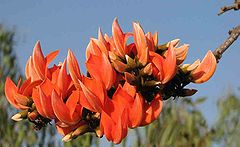Butea monosperma: Difference between revisions
Ekabhishek (talk | contribs) No edit summary |
No edit summary |
||
| Line 17: | Line 17: | ||
[[Image:Dhak (Butea monosperma) leaves in Kolkata W IMG 4265.jpg|thumb|left| leaves in [[Kolkata]], [[West Bengal]], [[India]]. ]] |
[[Image:Dhak (Butea monosperma) leaves in Kolkata W IMG 4265.jpg|thumb|left| leaves in [[Kolkata]], [[West Bengal]], [[India]]. ]] |
||
'''''Butea monosperma''''' (syn. ''[[Butea frondosa]]'', ''Erythrina monosperma'', ''Plaso monosperma''; '''[[Kinshuk]]''', '''[[Palash]]''', '''[[Dhak]]''', '''Flame of the Forest''', '''[[Bastard Teak]]''' or '''Parrot Tree'''), is a species of ''[[Butea]]'' native to tropical southern [[Asia]], from [[Pakistan]], [[India]], [[Nepal]], [[Sri Lanka]], [[Myanmar]], [[Thailand]], [[Laos]], [[Cambodia]], [[Vietnam]], [[Malaysia]], and western [[Indonesia]].<ref name=grin>Germplasm Resources Information Network: [http://www.ars-grin.gov/cgi-bin/npgs/html/taxon.pl?8177 ''Butea monosperma'']</ref> Also known as kesudo in Gujurati. |
'''''Butea monosperma''''' (syn. ''[[Butea frondosa]]'', ''Erythrina monosperma'', ''Plaso monosperma''; '''[[Kinshuk]]''', '''[[Palash]]''', '''[[Dhak]]''', '''Flame of the Forest''', '''[[Bastard Teak]]''' or '''Parrot Tree'''), is a species of ''[[Butea]]'' native to tropical southern [[Asia]], from [[Pakistan]], [[India]], [[Bangladesh]], [[Nepal]], [[Sri Lanka]], [[Myanmar]], [[Thailand]], [[Laos]], [[Cambodia]], [[Vietnam]], [[Malaysia]], and western [[Indonesia]].<ref name=grin>Germplasm Resources Information Network: [http://www.ars-grin.gov/cgi-bin/npgs/html/taxon.pl?8177 ''Butea monosperma'']</ref> Also known as kesudo in Gujurati. |
||
It is a medium sized [[dry season]]-[[deciduous]] [[tree]], growing to 15 m tall. The [[leaf|leaves]] are pinnate, with an 8-16 cm petiole and three leaflets, each leaflet 10-20 cm long. The [[flower]]s are 2.5 cm long, bright orange-red, and produced in [[raceme]]s up to 15 cm long. The [[fruit]] is a [[legume|pod]] 15-20 cm long and 4-5 cm broad.<ref name=rhs>Huxley, A., ed. (1992). ''New RHS Dictionary of Gardening''. Macmillan ISBN 0-333-47494-5.</ref> |
It is a medium sized [[dry season]]-[[deciduous]] [[tree]], growing to 15 m tall. The [[leaf|leaves]] are pinnate, with an 8-16 cm petiole and three leaflets, each leaflet 10-20 cm long. The [[flower]]s are 2.5 cm long, bright orange-red, and produced in [[raceme]]s up to 15 cm long. The [[fruit]] is a [[legume|pod]] 15-20 cm long and 4-5 cm broad.<ref name=rhs>Huxley, A., ed. (1992). ''New RHS Dictionary of Gardening''. Macmillan ISBN 0-333-47494-5.</ref> |
||
Revision as of 06:27, 9 April 2009
| Butea monosperma | |
|---|---|

| |
| In Bangalore, India | |
| Scientific classification | |
| Kingdom: | |
| Division: | |
| Class: | |
| Order: | |
| Family: | |
| Genus: | |
| Species: | B. monosperma
|
| Binomial name | |
| Butea monosperma | |

Butea monosperma (syn. Butea frondosa, Erythrina monosperma, Plaso monosperma; Kinshuk, Palash, Dhak, Flame of the Forest, Bastard Teak or Parrot Tree), is a species of Butea native to tropical southern Asia, from Pakistan, India, Bangladesh, Nepal, Sri Lanka, Myanmar, Thailand, Laos, Cambodia, Vietnam, Malaysia, and western Indonesia.[1] Also known as kesudo in Gujurati.
It is a medium sized dry season-deciduous tree, growing to 15 m tall. The leaves are pinnate, with an 8-16 cm petiole and three leaflets, each leaflet 10-20 cm long. The flowers are 2.5 cm long, bright orange-red, and produced in racemes up to 15 cm long. The fruit is a pod 15-20 cm long and 4-5 cm broad.[2]
It is used for timber, resin, fodder, medicine, and dye. The gum from the tree, called kamarkas in Hindi, is used in certain food dishes. The gum is also known as Bengal Kino, and is considered valuable by druggists because of its astringent qualities, and by leather workers because of its tannin. [3]
The wood is dirty white and soft and, being durable under water, is used for well-curbs and water scoops. Good charcoal can be made from it.
In West Bengal it is associated with Spring (season), especially through the poems and songs of Nobel Laureate Rabindranath Tagore, who likened its bright orange flame-like flower to fire. In Santiniketan, where Tagore lived, this flower has become an indispensable part of the celebration of spring.
It is said that the tree is a form of Agnidev, God of Fire. It was a punishment given to Him by Goddess Parvati for disturbing Her and Lord Shiva's privacy.
Other names
Flame of the Forest | Bastard Teak, Parrot Tree (Eng.), Chichra tesu, desuka jhad, dhak, palas, chalcha, kankrei (Hindi), Palashpapra (Urdu), Muthuga (Can.), Palas, Polashi (Beng.), Porasum, Parasu (Tam.), Muriku, Shamata (Mal.), Modugu (Tel.), Khakda (Guj.), Kela (Sinh.)[3]










